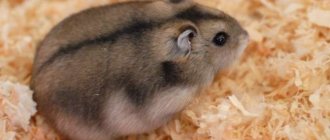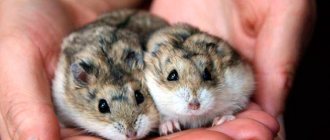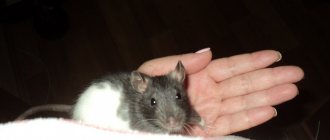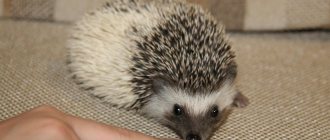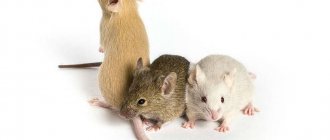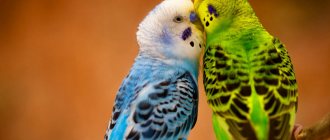Origin of Syrian hamsters
The species was first described by a 19th century zoologist. George Robert Waterhouse. In 1839, the scientist worked on compiling catalogs of mammals and birds brought by Charles Darwin from his trip around the world. Among the specimens was a Syrian hamster. Then, for a long time, this rodent was not encountered by natural scientists during their expeditions. It was considered extinct.
The Syrian hamster is also called the Central Asian hamster.
Only in 1930, near the Syrian city of Aleppo, another representative of this breed was found. Israeli biologist Israel Aharoni managed to find a pregnant female, who soon gave birth to 11 cubs. Within a year, Professor Aharoni had 150 rodents. After a couple of years, there were so many animals that he was able to send them to his colleagues in America and Europe, where they became widespread.
Description of the breed
The anatomy of the golden hamster allows it to carry large volumes of food that other rodents of similar size cannot carry at once. This is possible thanks to the cheek pouches. When filled, they double the volume of the head.
The animal is distinguished by its overall stockiness and short limbs. The front paws have 4 toes, and the hind paws have 5.
Habitat
Natural habitat - Central and South Asian steppes, Persian Gulf countries. There are representatives of the breed in Africa, Europe and America. Animals often choose to live in cultivated areas, parks and vegetable gardens - rich sources of food. Now wild individuals are rare. These are either pets or laboratory specimens.
Syrian hamsters are considered picky animals. They can adapt to living in almost any conditions.
Coat color and length
Syrian hamsters come in short-haired and long-haired varieties. Do not cross these species, because... the cub may become the owner of wool that does not fit into the breed standards.
The following color options are available:
- golden;
- black;
- white;
- yellow-brown;
- cream;
- dark grey;
- pearl;
- Agouti is a zoned coat color.
The most common shades are cream and golden. Coat color can change throughout the animal's life. Basically it becomes darker.
Thanks to the variety of types of Syrian hamsters, everyone can choose a pet to suit their taste.
Length and weight
Compared to their other relatives, Syrian rodents are quite large: body length is 13 cm or more, weight - 125-150 g. Females are larger than males.
Scent glands
The presence of scent, or marker, glands is a distinctive feature of golden hamsters. The glands secrete a special secretion that rodents use to mark their territory. Visually, these are 2 symmetrical black spots on the sides of the animal. The spots can be barely visible, or they can stand out strongly, having a rough surface and more like warts. Males have more pronounced glands. The rodent can rub its sides against the cage to leave a secret there and claim its territory.
A change in the appearance of the marker glands is a reason to consult a veterinarian. This may be a consequence of the development of inflammatory processes or cancer.
Character and lifestyle
The Syrian hamster, like many of its relatives, is more active at night. This is due to the peculiarities of the life of rodents in the wild, where they are forced to hide from predators. Twilight is a natural shelter. The animal was domesticated relatively recently, so its genetics and lifestyle did not have time to adapt to the new rhythm.
In their natural habitat, rodents dig tunnels and strive to create a home and pantry for themselves - a place to store supplies. If resources allow, the animal is capable of making supplies whose weight will exceed its own 100 times.
Under natural conditions, Syrian hamsters live in shallow burrows and are active at night.
The main behavioral characteristic of animals is activity. They are curious and friendly, but can become aggressive when frightened. To avoid this, pick up your pet carefully, without sudden movements. Give him time to get used to your smell and offer him a treat. This way the hamster will be more willing to make contact.
Rodents have intelligence, are able to recognize their owner and respond to a name.
Lifespan
On average, these pets live 2-3 years. Life expectancy directly depends on the conditions of detention and proper care.
Selection and arrangement of the cage
In the wild, animals are active and mobile. A properly selected cage will allow the animal to live in its usual rhythm and will be the key to its good health.
Requirements
The more spacious the cage and the more tiers it has, the better. Hamsters love stairs and passages. The rods should be metal: they let in a lot of light and air, and it is impossible to chew through them. It is better to choose a plastic tray: it is easy to care for and does not absorb odors. A mandatory element of the home is a special house where the hamster will hide and stock up.
Syrian hamsters are relatively large in size, so a small cage is not suitable for keeping such a pet.
Drinker and food bowls
When choosing a bowl for food, it is better to give preference to a ceramic one, because... it is more stable compared to plastic. Place it on one of the upper tiers - this will protect the container from dust and debris.
Ceramic dishes can also be used for water, which should always be in the cage. The sides should not be high so that the hamster does not have to stretch. Sometimes inexperienced breeders have concerns that the animal may accidentally choke when left unattended. But this option of supplying water is considered more natural and convenient for the animal. If you choose the right bowl and pour no more than 100 ml of liquid, no harm will happen.
There are special sippy cups in the form of bottles. They are attached to the cell walls using suction cups or hooks. The rodent receives water through a straw. The water in such a drinking bowl is protected from dust and debris. But the bottle requires careful care. If hygiene is poor, mold will quickly form inside.
Sports area
Sports activity is an important factor influencing the lifespan of a Syrian hamster. A running wheel should be a must-have exercise machine. It is better to choose a model without crossbars and with a small distance between the rods so that the animal’s paws do not fall through. Securely attach the exercise machine to the wall of the cage or install it inside using a special stand.
If space allows, add mazes and obstacle courses. This will diversify your pet’s leisure time and provide additional physical activity.
Filler
The bottom of the cage must be sprinkled with a layer of filler. It is needed to neutralize odor and absorb pet waste. Pressed sawdust is well suited for these purposes. They will not cause harm if the animal decides to chew them a little or use them to decorate their home.
Good bedding for a hamster's cage is no less important than quality food.
Cleaning
You need to keep order in your rodent’s home every day: change water and food, spot remove dirty litter, throw away spoiled food. Wash the cage once a week and completely change all the litter. It is recommended to use gentle cleaning agents without a strong odor. To remove heavy stains, use a weak solution of vinegar.
Supplies in the house should be periodically reviewed, but if the food has not spoiled, do not throw it away.
Additional accessories
When you equip the cage with everything necessary for a comfortable life for your pet, take a closer look at the accessories. They won't let your pet get bored. There is a wide choice: hammocks, plastic and plush tunnels, slides, cotton wool nests, rings and even special play complexes.
Features of keeping hamsters at home
There is nothing complicated in caring for and maintaining Djungarian hamsters at home, but you need to know some nuances. For example, that these animals are very sensitive to microclimate and stress. In addition, errors in feeding and care can lead to illness or death of the pet.
Microclimate
Djungarian hamsters feel comfortable at temperatures from +18 to +26 degrees. It is not recommended to keep them on an uninsulated loggia or place the cage near a heating radiator. A suitable humidity level is 55-65%.
Rodents are afraid of dampness. In such conditions, animals often suffer from colds and become more vulnerable to bacterial and viral infections.
Another enemy of the Djungarian hamster’s health is draft. When caring for a rodent, the level of lighting should also be taken into account. Too bright light is irritating. In the wild, hamsters emerge from their burrows only in the dark. Therefore, experts recommend slightly shading the cage for the Djungarian hamster so that the sun's rays do not get inside.
Cage selection and equipment
To make caring for your rodent easier, you need to choose the right cage for it. The most suitable option is a metal lattice structure. Its main advantage is good ventilation.
Some people keep Djungarian hamsters in aquariums. If the choice falls on such a home, then the animal will be forced to constantly breathe fumes of ammonia and hydrogen sulfide. These substances are released into the air when rodent feces decompose.
Cage requirements:
- minimum size – 30x50 cm;
- retractable tray for easy care of the hamster;
- tightly closing door at the bottom of the structure;
- The width between the rods is no more than 0.8 cm.
There may be several tiers, then the dzhungarik will have more free space to move. The floors are connected to each other by stable, flat stairs or tunnels.
When caring for Djungarian hamsters, it is important to pay attention to hygiene. You need to choose a good filler that quickly absorbs moisture and masks the unpleasant odor.
Newspapers, napkins, paper are not the most suitable option.
Experienced breeders recommend using the following types of fillers as bedding:
- corn;
- cellulose;
- pressed sawdust.
Those who prefer wood filler need to study its composition. It should not contain coniferous sawdust - spruce, pine. This wood contains a lot of essential oils, which often cause allergies in hamsters.
Caring for a Djungarian hamster involves ensuring comfort inside the cage. The animal will need equipment:
- 2 feeders – for grain and wet food;
- drinking bowl;
- running wheel;
- holiday house;
- toilet.
This is the required minimum. If space allows, you can place a small piece of driftwood on the floor and secure the branches so that the Djungarian hamster can climb on them. Some owners note that their pets love to climb into a hanging hammock. You can sew it yourself or buy it ready-made at a pet store.
The Djungarian hamster's home needs to be kept in order. The filler is replaced regularly - every 5-7 days. If this is not done, an unpleasant odor will appear. All equipment is washed and scalded with boiling water. The tray is treated with soda solution.
Feeding
High-quality care for the jungarik includes providing the animal with adequate nutrition. The basis of the diet is a grain mixture. Pet stores sell special food for Djungarian hamsters, which includes:
- wheat;
- millet;
- oats;
- buckwheat;
- peas;
- peanut;
- Walnut;
- raisin;
- sunflower seeds;
- corn.
The richer the composition, the better. In addition to the grain mixture, hamsters can be given vegetables - carrots, zucchini, cucumber, cauliflower, broccoli. Apples, pears, and sour berries are allowed as fruits.
The diet must include greens - alfalfa, dandelion and plantain leaves, lawn grass. In winter, all this can be replaced with dry herbal granules.
Twice a week, Djungarian hamsters are given a little low-fat cottage cheese, boiled chicken breast and egg yolk.
List of prohibited products:
- citrus fruit;
- Red beetroot;
- cheese;
- fish;
- any salty and sweet food;
- bread, cookies;
- sour cream;
- butter;
- honey;
- sausages;
- smoked meat;
- onion;
- potatoes in any form.
Branches of fruit trees or bushes are left in the cage. Dzungarik grinds down his constantly growing teeth when he gnaws on such a delicacy.
Breeding
Djungarian hamsters cannot be kept together. Both same-sex and opposite-sex individuals are housed separately from each other - either in different cages, or in one large one, separated by a partition. To organize mating, it is necessary to place the female with the male.
Mating is possible on certain days. You need to wait until the female goes into heat. In Djungarian hamsters it occurs every 4 days. At this time, the female is loyal to the male and allows him to get closer to her.
Attention! Puberty in Djungarians occurs at one month of age, but this is not the right time for the first mating. The female is not yet ready for pregnancy and childbirth. It is better to wait until she is 3-4 months old.
After mating, the hamsters are seated. The absence of another heat indicates pregnancy, which lasts 21 days. During this period, the expectant mother needs good care and proper nutrition. She should not be disturbed, as any stress can harm her health.
There are 4-6 babies in a Djungarian hamster litter. They are born blind, deaf and completely bald. Caring for newborns is not required - the female does everything herself.
Babies should not be picked up until their eyes open. This occurs 2 weeks after birth. By the age of one month, hamsters become adults and are removed from their mother.
Syrian hamster nutrition
The activity, immunity and lifespan of a rodent largely depend on its diet. To create a balanced menu, you need to know the feeding behavior of an animal in the wild.
Mode
The hamster is a nocturnal animal, its activity time falls at dusk.
Divide the daily amount of food into 2 meals. In the evening, the portion of food should be larger than in the morning.
Diet
In their natural habitat, the diet of rodents includes the following components:
- cereal grains;
- greens, fruits and vegetables;
- insects and worms, i.e. protein.
You need to feed your pet in a balanced manner at home.
The Syrian hamster's diet should be well balanced.
The hamster's diet consists of cereals:
- wheat:
- rye;
- oats;
- corn;
- millet.
Add peanuts, nuts, dried peas, sunflower seeds, watermelon and melon to your menu.
You can buy ready-made cereal mixture. If you prepare the food yourself, keep in mind that peanuts and nuts are high in fat. Their content in the total mass of the finished product should not exceed 10%.
Feed your rodent plant foods daily.
It can be greens, clover, plantain, lettuce, parsley, dill. It is better not to include wormwood and dandelion (especially its stems) in the animal’s diet.
Fresh vegetables allowed:
- carrot;
- cucumber;
- zucchini;
- radish;
- Bell pepper.
The following fruits are suitable as a treat:
- apples;
- bananas;
- pears;
- peaches.
It is not worth giving them often, because... they contain a lot of sugar. For the same reason, dried fruits should be excluded from the rodent’s diet. But you can treat your hamster with berries every day.
On average, a rodent should receive about 30 g of cereals, 20 g of vegetables and herbs every day. Additionally, you can offer your pet 1-2 nuts and a few pieces of fruit.
Several times a week the animal should receive 5 g of protein food.
Low-fat cottage cheese, boiled eggs and chicken are suitable. In pet stores you can purchase insects and worms specifically designed for feeding.
Toys for grinding teeth
Rodents' teeth constantly grow. Give your pet a tree branch to grind them down. Recommended are beech, apple, birch, oak, cherry, pear, birch, and willow. Coniferous tree branches should not be given.
The mineral ring must be kept in the Syrian hamster's cage at all times.
There are special mineral stones for rodents on sale. They not only help to grind teeth, but also add useful substances to the pet’s diet: calcium, phosphorus, iron, selenium.
Syrian hamsters: care and maintenance
Caring for hamsters is not difficult, so even children can handle it. The main thing is to choose the right cage, provide the hamster with proper leisure and proper nutrition.
Let's look at the main questions that concern the owners of a Syrian pet:
- Where should a hamster live?
Of course, you need to purchase a cage for a new family member. Make sure that its size is no less than 30 by 40 cm. A glass aquarium of the same size is also suitable for hamsters.
Sawdust should be placed at the bottom of the cage. Try to keep their layer at least three centimeters. It is prohibited to use cotton wool, paper and rags. You can put some straw in the cage, which your pet will use to build a nest.
If your hamster has long hair, avoid sawdust. Replace them with special wood filler.
Photo: pixabay.com: UGC
So you've lined the bottom of the cage, what next? Place a drinking bowl and food bowl in your hamster's home. Also arrange a toilet for the animal, equipping it with a special filler.
It is worth putting a special wheel in the cage, which hamsters love. You can equip your pet's home with small perches or other obstacles.
- What to feed a hamster?
Now a few words about nutrition, because you are interested in what hamsters eat. The diet of the new family member should be based on special grain feed. However, the hamster's menu can and should be diversified.
Feel free to give your pet the following foods:
- pieces of apples, pears, pumpkins, carrots, radishes, zucchini;
- grasses - alfalfa and clover;
- boiled chicken;
- a little milk or low-fat cottage cheese;
- boiled egg yolk.
Sometimes hamsters can eat white bread or pasta.
If you do not want health problems, do not give your pet chocolate, nuts, black seeds, citrus fruits, cabbage, lard, kefir and yogurt.
Photo: pixabay.com: UGC
Feed your hamster twice a day, strictly watching portions. Be sure to fill the drinking bowl with water and change it daily.
Rules for caring for a Syrian hamster
Syrian hamsters are easy to care for. For a pet to live comfortably, it is necessary to keep the cage clean and provide regular and balanced nutrition.
Walks and games
If the animal's cage is equipped with everything necessary, then it does not require additional walks.
If you want to let your pet roam around the apartment, purchase a special ball. The hamster will not be able to escape from it and will always be in sight.
What not to do
You should not let your hamster out on the street: in the grass you will quickly lose sight of him.
Protect the animal from falling from heights. The bones of his skeleton are fragile, and any fall can end sadly, even fatally. Be careful when handling your pet. Don't leave him outside his cage unattended.
Is it worth getting a hamster?
Pros of keeping a hamster
- You don't need a lot of space.
A hamster is not a Rottweiler. You don't have to buy a private home to own one. And even the size of the apartment does not matter. A hamster will need a tiny cozy corner in your home where you can install a cage. All!
- Easy care.
You don't need to walk your hamster twice a day. He doesn’t need to be bathed, combed, litter trained, and he doesn’t even need to be taught commands. It is enough to keep the cage clean and feed the baby correctly - this is the main care.
- No behavior problems.
A friend complains that the cat has torn off all the wallpaper in the house? Does your neighbor's dog bark loudly and keep you from sleeping at night? There will be no such problem with a hamster. This baby lives quietly in her cage, does not lay claim to your property and does not dream of “marking” your slippers. The worst thing a hamster can do to you is make a little noise at night. He is, after all, a nocturnal animal - he’s allowed!
- You can safely go on vacation.
Hamsters are unpretentious pets. They don't need your attention 24/7. You can easily leave for a couple of days on business or go on vacation, and your pet will have a great time alone!
Just buy a special automatic feeder and drinking bowl for your rodent, into which you can pour food and pour in plenty of water. And arrange with your relatives or friends to drop by for 5 minutes a couple of times a week: clean the cage and just check on the baby.
- Economical content.
Before the hamster comes home, you will have to spend a little money: buy a cage, a house, a drinking bowl, a feeder, food, a mineral stone, various toys and bedding. This is where the main expense item ends. In the future, you will only have to buy food and litter.
These are the main arguments in support of hamsters. And we didn’t even mention that they are just wildly cute and it’s interesting to watch their habits. You know this yourself!
Disadvantages of keeping hamsters
- The hamster is not human-oriented.
Hamsters are not human-oriented. They do not get much pleasure from communicating with us and get along just fine without it. Of course, a well-mannered, tamed hamster can, for the sake of decency, sit on your palm, climb onto your shoulder and allow itself to be petted. But at this moment he will most likely dream of escaping back into the cage and staying in the best company - himself!
A hamster is an animal that is best observed from the sidelines and minimally interfered with its life. If you dream of a tame pet who will be happy to interact with you, it is better to choose a guinea pig, degu or... a cat. “The Murderers” are champions in this matter!
- A hamster can bite.
Hamsters are often kept as a child's first pet. But there is a pitfall here: a cautious rodent can easily bite an obsessive owner. You can’t explain to him that you can’t offend children. And it’s difficult for children to restrain themselves from squeezing the cheeky baby. To avoid trouble, parents always need to be vigilant, regularly explain the rules for handling a rodent, and not leave children and pets unattended.
- A hamster is easily injured.
If you have a hamster at home, you need to turn into a superhero to protect this little one from all dangers. This is especially true for families with children. The child does not yet know how to measure his strength and may accidentally injure the baby.
Other pets are a separate issue. If you have a cat or dog, your hamster needs to be safely isolated from them. A metal cage is good, but it's not just about direct contact. If a cat and a dog constantly “circle” around the cage, guarding their little neighbor, such living will result in enormous stress for the hamster. Don't condemn the animal to this.
- A hamster can get lost in an apartment.
Of course, this is not as scary as if a dog or cat ran away. On the other hand, a huge number of dangers await a baby running around the apartment. He might eat something he shouldn’t, get stuck somewhere, something might fall on him... Perhaps we’ll stop with these horror stories.
The main thing is to try to prevent escape. And if you release your hamster from its cage, do not leave it unattended.
- The hamster makes noise at night.
Hamsters are nocturnal animals. Be prepared that they sleep during the day and rustle and rush around the cage at night. Of course, this is not as serious as the night howling or May songs at 5 am. But if you have sensitive sleep, nighttime hamster vigils can be a problem.
- Hamsters don't live long.
And this is perhaps the main disadvantage. Hamsters live from 1.5 to 4 years. It will be difficult to part with your beloved pet.
As a conclusion
If you decide to get a hamster, remember two main rules.
First. Hamsters should be liked by all members of your family who will live with the pet in the same house. If rodents are unpleasant to someone in the household, it is better to think about another pet. Moreover, a child is not worthy of a hamster, and you yourself do not like hamsters. The main concern for the rodent will still fall on you. You will have to force yourself to interact with him. And this will not bring happiness to either you or the furry baby.
And second. Hamsters are tiny, unpretentious pets. But they are by no means toys. Yes, a hamster does not require as much attention as a dog or cat. But he is also a member of the family. He also needs to be taken care of, he can also get sick and need your help, he also needs to be loved and taken care of. Then everything will be great!
Reproduction of Syrian hamsters
Rodents reach sexual maturity at 6 weeks. But for breeding it is better to choose individuals no younger than 4-6 and no older than 18 months. Avoid crossing blood relatives, because this can lead to genetic mutations and deformities in the offspring.
After birth, you should not touch the cubs with your hands, otherwise the female is able to eat all her offspring if she senses the presence of foreign odors.
Pregnancy period
A pregnant female should be fed protein foods and kept separate from other hamsters, because she can be aggressive. Gestation lasts about 16 days.
Offspring
From 8 to 12 individuals are born in a litter. The lactation period is 20 days. If you do not provide the female with adequate nutrition during pregnancy and feeding her offspring, she may eat her cubs.
How to properly care for a hamster
Hamsters are furry rodents that are convenient and easy to keep at home. They do not make noise, take up little space, and do not need to be walked. But even such a small animal should be provided with the right and comfortable conditions.
The rules for caring for a hamster are simple, and even a child can handle them. Here are a few of them:
- Be sure to buy a cage; do not keep your hamster in a jar or aquarium.
- If you are moving your hamster into a new cage, do it using a special tube. Release the animal into a new territory, pushing it with your palm.
- Make sure your hamster has something to grind his teeth on. Buy a special chalk for rodents.
- Clean the cage twice a week. When you change the litter and wash the house, move the hamster to another place.
- Buy your pet a labyrinth through which he can run. The main thing is that the tubes are wide and without sharp elements. Let your hamster run around in a special ball.
- Watch the claws of a rodent (especially an old one). Trim them carefully with nail scissors. Do not use a file to avoid injuring the animal. If injured, bandage the paw and clean the cage so that the wound does not become dirty.
- Only bathe your hamster in extreme cases. Make sure that the input does not get into your ears or eyes when bathing. Use rodent shampoo. After water treatments, hold the animal in your hands so that it calms down.
A hamster is susceptible to stress, so take care of its nervous system. Do not shout near the cage or shake it. There is no need to add “neighbors” to your hamster, especially if you do not plan to increase offspring. If you put two same-sex hamsters in a cage, they may fight over territory.
Do not clean the house if the hamster is in it. Take the hamster away, and then clean the cage.
Do not walk your hamster outside or let it out into the grass. The sun's rays are destructive to the rodent, and it will run away in the grass and you will not find it.
Don't wake your hamster when he's sleeping and don't disrupt his routine.
Do not offend or hit the animal.
Interesting facts and myths
In ancient times, hamsters were associated with evil spirits and witchcraft.
A hamster is not a toy, but a pet that requires attention and proper care.
Now they are shrouded in completely different myths:
- These are living toys. A hamster should not be considered a toy. It requires care and respect. The animal can be tamed, but it will take effort.
- It is impossible to get rid of the cage smell. If the filler is replaced in a timely manner, there will be no unpleasant odors. The hamster is clean.
- The pet does not need water. This is wrong. Without drinking water, the animal will die.
Interesting Facts:
- The animals are used in laboratory research. They are susceptible to human viruses and have a similar tooth structure to ours.
- Matriarchy reigns among rodents of this species. The female is larger than the male and decides who will be the father of the offspring.
- In England there is a club of golden hamster lovers, which publishes its own newspaper and regularly selects a hamster of the month.
